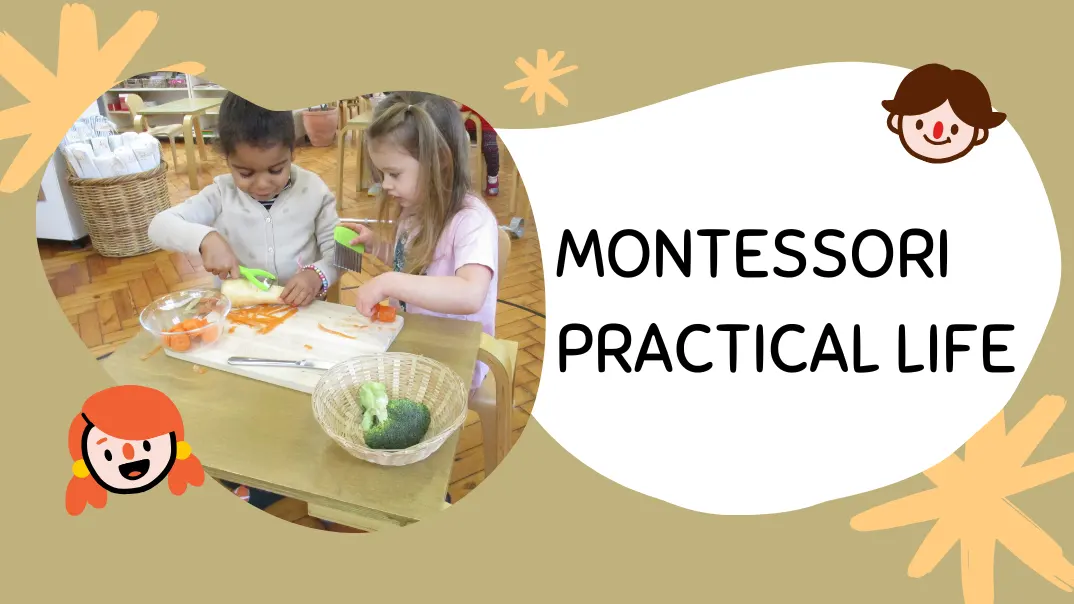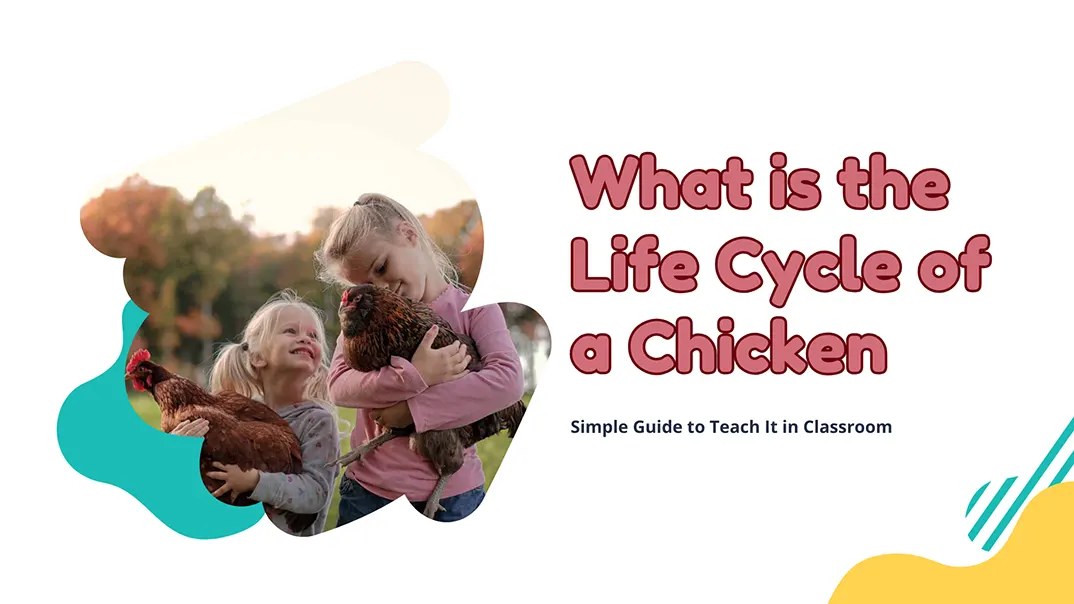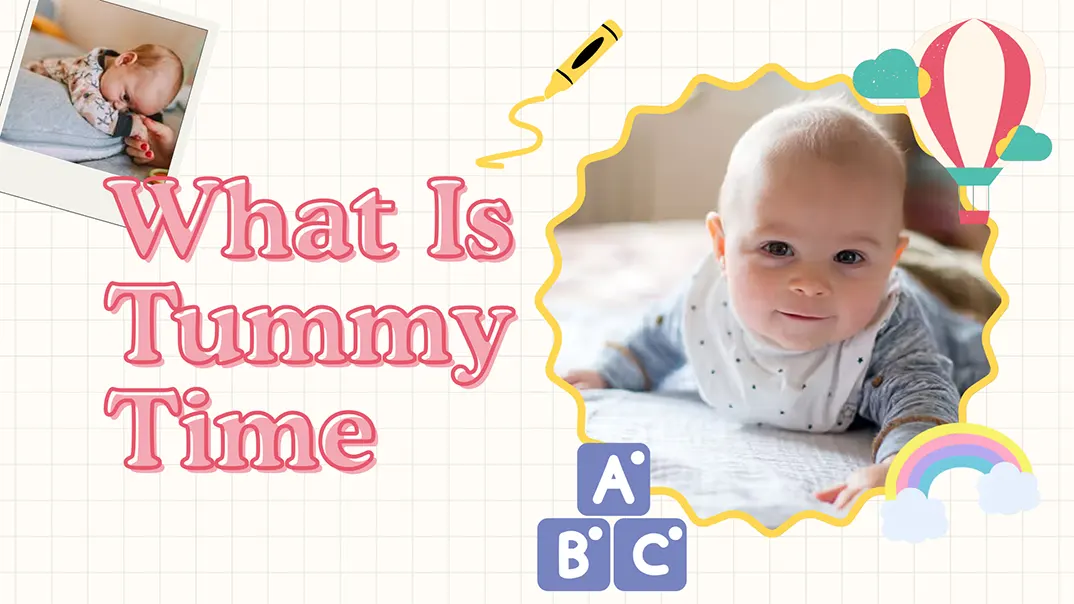Are you worried your child isn’t gaining the independence or life skills needed to thrive? This concern is common among parents, especially as children often seem unmotivated to take on responsibilities. Montessori Practical Life activities offer a hands-on, structured way to foster independence, focus, and confidence in children, turning everyday tasks into opportunities for growth.
Montessori Practical Life activities teach children essential life skills, promote independence, and foster a sense of responsibility. Through hands-on, real-world tasks, children develop concentration, confidence, and the ability to care for themselves and their environment.
Are you curious to learn how these activities work and how you can incorporate them into your child’s daily life? Let’s dive into a comprehensive guide on Montessori Practical Life.
What is Montessori Practical Life?
Montessori Practical Life encompasses purposeful, everyday activities to help children develop essential life skills. These tasks range from pouring water and tying shoelaces to sweeping floors and preparing food. While they may seem mundane to adults, they are extraordinary tools for fostering a child’s physical, emotional, and cognitive growth.
The Purpose of Practical Life
At its core, Practical Life aims to bridge the gap between a child’s home and the classroom. These activities connect children to their environment and can contribute meaningfully to their family or school community. This sense of belonging and achievement nurtures their self-confidence and inspires them to take on greater challenges.
Moreover, these activities align with Montessori’s philosophy that children have an innate desire to learn and imitate adults. Through hands-on work, they internalize important values such as discipline, patience, and care for others.
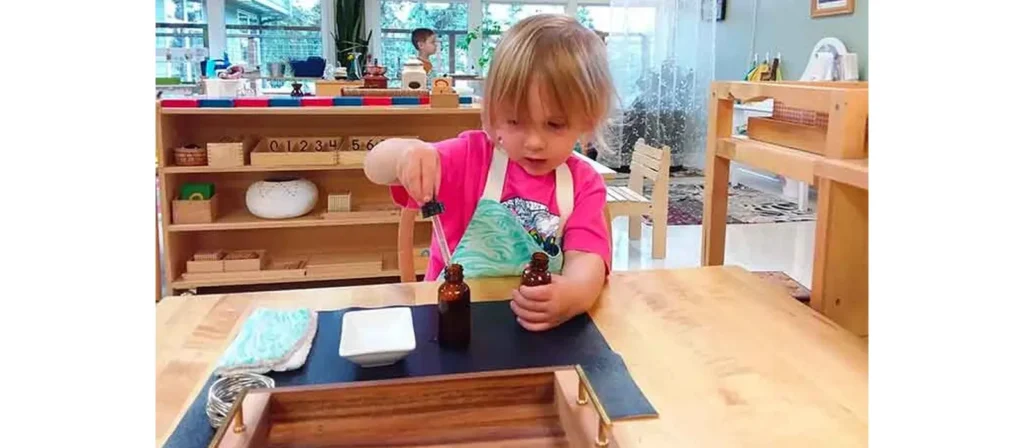
Benefits of Montessori Practical Life
Montessori Practical Life activities offer a wide array of developmental benefits. Let’s explore these advantages in depth:
1. Development of Motor Skills
Practical Life activities strengthen motor skills:
- Fine Motor Skills: Tasks like transferring objects with tweezers or threading beads develop precise hand movements, which are critical for writing and drawing.
- Gross Motor Skills: Activities like sweeping, carrying items, or pouring water help children refine larger body movements, improving balance and coordination.
These motor skills provide the foundation for academic tasks, such as holding a pencil or cutting scissors.
2. Responsibility
Children learn to care for themselves, their belongings, and their environment. For example, watering plants or organizing their toys teaches accountability and respect for their surroundings. These lessons extend far beyond childhood, shaping responsible adults.
3. Independence
Montessori Practical Life is rooted in empowering children to perform tasks independently. Even something as simple as putting on their shoes builds self-reliance and confidence, showing them they can handle challenges independently.
4. Concentration
Engaging in repetitive, focused tasks helps children develop sustained attention and focus. Practical Life activities are intentionally designed to require precision and care, fostering a habit of concentration that supports learning in other areas.
Transform Your Classroom with Custom Furniture Solutions
5. Self-Esteem
Completing tasks—even small ones like tying shoelaces—gives children a sense of achievement. This boosts their confidence and self-esteem, helping them approach new challenges positively.
6. Social Skills
Grace and courtesy lessons within Practical Life teach children how to interact respectfully with others. For instance, children learn to say “thank you,” wait their turn, or help a friend, laying the groundwork for strong interpersonal relationships.
7. Cognitive Development
Practical Life tasks involve sequencing, problem-solving, and logical thinking. Whether it’s following steps to set a table or deciding how much water a plant needs, these activities stimulate cognitive growth.
8. Order and Organization
Children naturally crave order. Practical Life activities encourage them to systematically organize materials, follow routines, and complete tasks. This helps them develop a love for structure and discipline, which is essential for success in all areas of life.

Montessori Practical Life Curriculum
The Practical Life curriculum is thoughtfully structured to accommodate children at different developmental stages. Each level builds upon the previous, gradually increasing in complexity.
1. Basic Self-Care and Coordination
For younger children (ages 2–3):
- Handwashing: Teaching hygiene and the ability to follow steps.
- Pouring Water: Using small pitchers to develop hand-eye coordination.
- Dressing Frames: Practicing zippers, buttons, and laces.
- Carrying Objects: Building gross motor skills with balance.
2. Advanced Motor Skills and Environmental Interaction
For children ages 3–4:
- Cleaning Activities: Dusting furniture, wiping tables, and sweeping floors to promote responsibility.
- Plant Care: Watering and pruning plants, teaching care for living things.
- Food Preparation: Simple tasks like peeling bananas, spreading butter, or slicing fruits.
3. Housework and Creative Expression
For children ages 4–6:
- Folding Laundry: Instilling order and fine motor control.
- Flower Arranging: Encouraging creativity and an appreciation for beauty.
- Organizing Shelves: Practicing logical arrangement and spatial awareness.
4. Cooking Skills and Complex Crafts
For older children (ages 6+):
- Measuring Ingredients: Introducing math concepts through cooking.
- Baking: Combining precision and creativity.
- Sewing and Weaving: Enhancing skill and patience.

Montessori Practical Life Areas Include
Practical Life activities are divided into four primary areas, each with its own set of goals and benefits:
Self-Care
Children learn to care for their needs, such as grooming, dressing, and maintaining hygiene. Tasks like tying shoelaces or using a hairbrush build autonomy and self-respect.
Environmental Protection
Activities in this area focus on maintaining the space around them. Examples include sweeping, mopping, and organizing shelves. These tasks instill a sense of responsibility and respect for shared spaces.
Grace and Courtesy
Social interactions are a vital part of Practical Life. Children practice polite behaviors, such as greeting others, offering help, or saying “Excuse me.” These lessons prepare them for harmonious relationships in the future.
Controlled Movement
Tasks that involve precision, such as pouring water into glasses or carrying trays without spilling, teach balance, control, and deliberate action. These activities refine coordination and mindfulness.
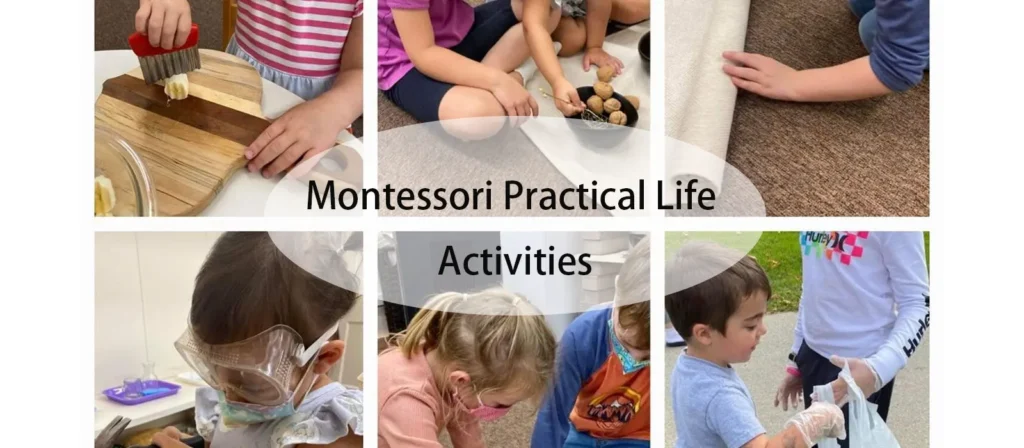
Montessori Practical Life Activities
Montessori Practical Life activities are incredibly diverse and adaptable, catering to children’s developmental needs while preparing them for real-life challenges. These activities are carefully designed to foster independence, coordination, and a sense of responsibility. Below, we’ll explore these activities in greater detail, with additional examples organized under various subcategories.
1. Everyday Montessori Practical Life Activities
These are the foundational activities that children encounter in both their home and classroom environments.

Pouring and Transferring
- Purpose: Enhances fine motor skills, hand-eye coordination, and focus.
- Examples:
- Pouring water from one pitcher to another.
- Transferring small beads using a spoon or tweezers.
- Using a funnel to transfer liquids without spilling.
Washing and Cleaning
- Purpose: Teaches responsibility and environmental care while improving gross motor coordination.
- Examples:
- Washing tables with a sponge and water.
- Cleaning windows using a small spray bottle and cloth.
- Polishing wooden furniture with safe, natural cleaning products.
Folding and Organizing
- Purpose: Promotes order, sequencing skills, and attention to detail.
- Examples:
- Folding napkins or towels into neat squares or triangles.
- Organizing toys or books on shelves by size or category.
- Rolling up mats after activities.
Dressing Practice
- Purpose: Develops independence and refines fine motor skills.
- Examples:
- Practicing buttoning and unbuttoning on dressing frames.
- Using zippers, buckles, and Velcro to secure clothing.
- Learning to tie shoelaces step-by-step.
Transform Your Classroom with Custom Furniture Solutions
2. Advanced Practical Life Activities
As children grow, they are ready to tackle more complex and multi-step tasks that challenge their abilities.

Food Preparation
- Purpose: Introduces basic cooking skills while teaching math and sequencing concepts.
- Examples:
- Cutting soft fruits like bananas or strawberries with a child-safe knife.
- Spreading butter, cream cheese, or jam on bread.
- Juicing oranges with a manual juicer and serving the juice.
Polishing and Maintenance
- Purpose: Instills attention to detail, patience, and care for belongings.
- Examples:
- Polishing silverware or brass using non-toxic polish.
- Cleaning and organizing shoes, including brushing and shining them.
- Maintaining classroom tools, such as dusting shelves or wiping chalkboards.
Sewing and Crafting
- Purpose: Encourages creativity, persistence, and fine motor development.
- Examples:
- Threading needles and sewing buttons onto fabric.
- Creating patterns with simple embroidery stitches.
- Making felt ornaments or small decorative items.
3. Social Practical Life Activities
Montessori Practical Life goes beyond individual tasks to include activities that build social awareness and collaboration.
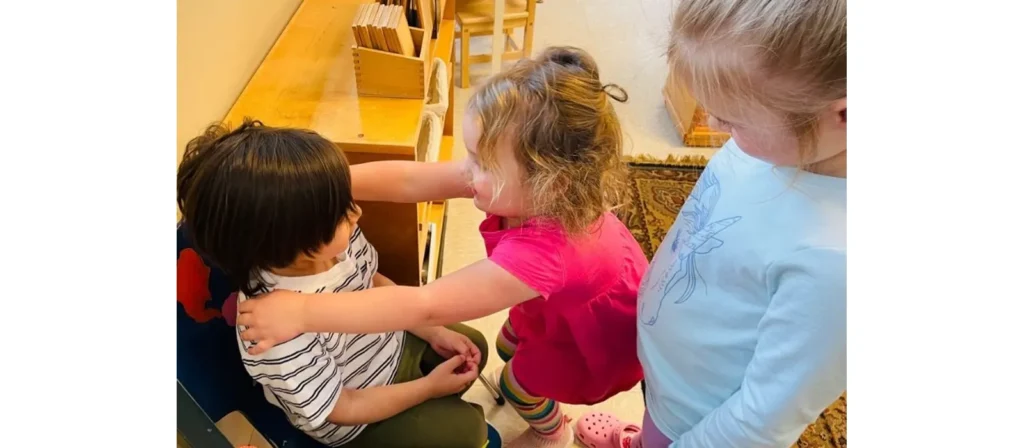
Grace and Courtesy
- Purpose: Enhances empathy, respect, and social skills.
- Examples:
- Practicing how to greet guests with a handshake and smile.
- Role-playing polite conversations, such as asking for help or offering assistance.
- Learning to serve snacks or meals to peers during group activities.
Team Collaboration
- Purpose: Teaches cooperation, patience, and teamwork.
- Examples:
- Working together to set a table for lunch or a special event.
- Taking turns during group cleaning projects like sweeping a large area.
- Collaborating on gardening tasks, such as planting a communal flower bed.
4. Creative and Aesthetic Practical Life Activities
These activities focus on cultivating beauty, creativity, and an appreciation for the arts.
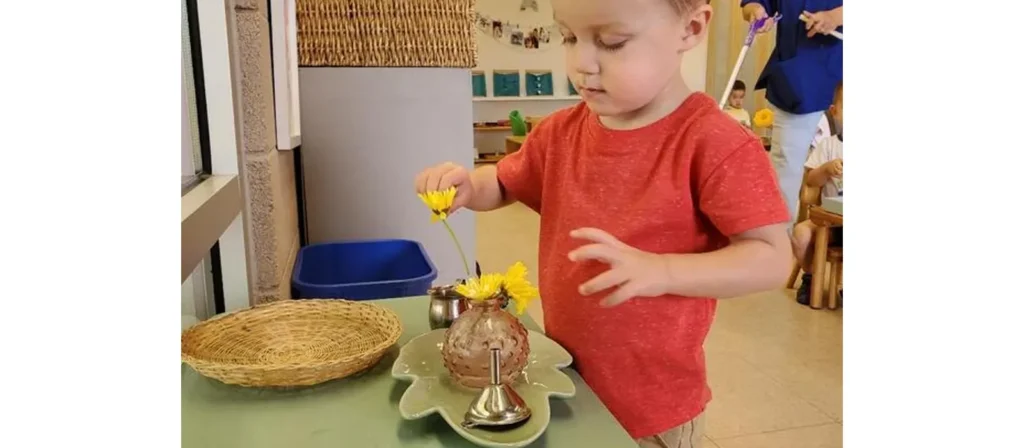
Flower Arranging
- Purpose: Encourages creativity, spatial awareness, and a love for nature.
- Examples:
- Cutting flower stems to fit various vase sizes.
- Arranging flowers aesthetically to decorate a table or room.
- Learning to care for floral arrangements by replacing water daily.
Artistic Expression through Crafts
- Purpose: Combines motor skills with artistic exploration.
- Examples:
- Designing and assembling greeting cards for special occasions.
- Painting small pots for classroom plants.
- Creating collages from natural materials like leaves and twigs.
5. Practical Outdoor Activities
Practical Life isn’t confined to indoor spaces; outdoor activities also play a vital role in children’s learning.
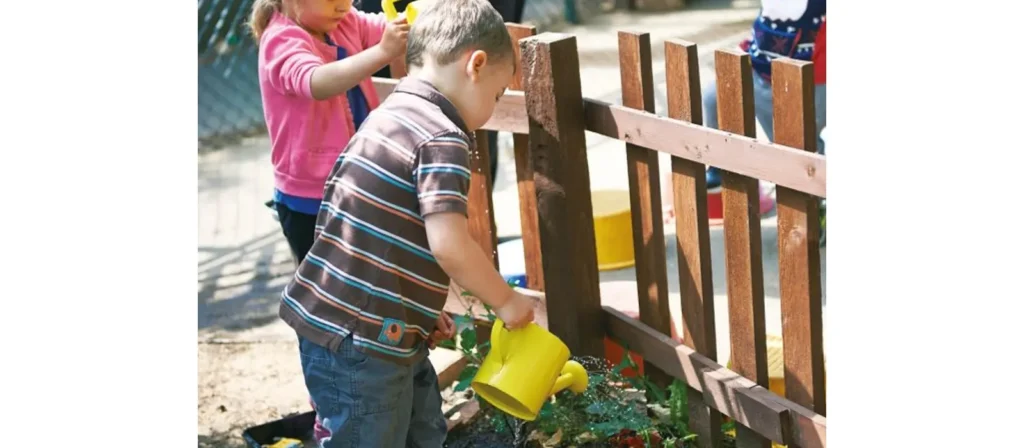
Gardening and Plant Care
- Purpose: Connects children to nature and teaches patience and responsibility.
- Examples:
- Planting seeds and monitoring their growth.
- Pulling weeds and maintaining a clean garden bed.
- Harvesting fruits, vegetables, or herbs and using them in meals.
Outdoor Cleaning Tasks
- Purpose: Encourages responsibility for communal spaces.
- Examples:
- Sweeping porches or patios with a small outdoor broom.
- Picking up litter in a supervised setting.
- Washing outdoor furniture or play equipment.
Building Outdoor Skills
- Purpose: Develop practical problem-solving abilities and teamwork.
- Examples:
- Setting up picnic areas or outdoor workstations.
- Constructing simple structures like a small garden trellis.
- Learning to use basic gardening tools, like trowels and rakes, safely.
Transform Your Classroom with Custom Furniture Solutions
Montessori Practical Life Practice Tips
To get the most out of Montessori Practical Life activities, keep these tips in mind:
- Start Small
Begin with simple tasks that match your child’s age and ability, such as pouring water or wiping a table. - Model the Activity
Demonstrate the steps of an activity slowly and clearly before letting your child try. For example, show how to fold a towel step-by-step. - Provide the Right Environment
Create a child-friendly space with accessible shelves, child-sized tools, and organized materials. Ensure that the environment feels welcoming and safe. - Emphasize Process Over Perfection
Focus on the process rather than the outcome. Celebrate your child’s effort rather than pointing out mistakes. - Encourage Repetition
Allow your child to repeat tasks until they feel confident. Repetition builds mastery and self-assurance. - Use Real Tools
Avoid toy versions of materials. Provide real but child-sized tools, such as small brooms, brushes, or safe knives. This teaches children the value of using authentic materials. - Incorporate Activities Into Daily Life
Practical Life doesn’t need to be a separate event. Let your child participate in everyday tasks, such as helping set the table or sorting groceries. - Be Patient and Observant
Let your child work independently, and observe their interests to introduce new, engaging activities. - Rotate Activities Regularly
Keep your child’s interest alive by rotating activities weekly to balance familiar and new tasks.
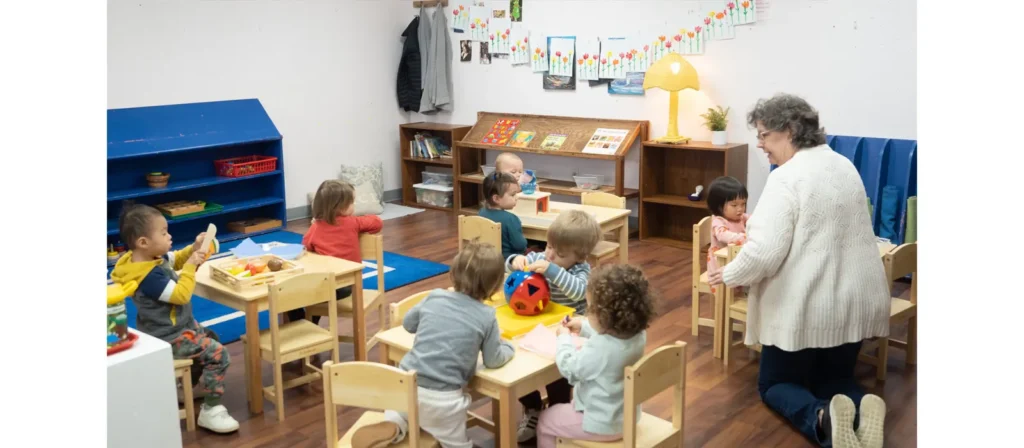
Setting Up a Montessori Practical Life Area
Creating a Montessori-friendly space at home or in the classroom ensures children can engage in Practical Life activities independently and safely.
Tips for Setting Up the Area
- Child-Sized Materials: Use tools and furniture that fit the child’s size.
- Accessible Layout: Arrange items within the child’s reach for easy access.
- Natural Materials: Opt for wooden tools, glass, and other natural materials over plastic.
- Clear Organization: For each activity, keep the space tidy with trays or baskets.
- Realistic Tasks: Provide real tools and tasks rather than toy replicas.
Montessori Practical Life Materials
Montessori Practical Life materials are designed to be functional, purposeful, and attractive. They make tasks manageable for children and instill a sense of respect for tools and their uses.
How to Choose the Right Montessori Practical Life Materials?
- Size Matters
Select tools and materials that are appropriately sized for your child’s hands to ensure ease of use. - Prioritize Quality
Choose durable, natural materials like wood, glass, or metal. These feel authentic and are more sustainable than plastic alternatives. - Opt for Simplicity
Avoid overly complicated or flashy materials. The focus should be on the task, not distractions. - Safety First
Ensure all materials are safe for children to handle, with no sharp edges or toxic finishes. - Encourage Independence
Pick materials children can use and maintain independently, such as pitchers with easy-to-grip handles or sponges that fit their hands.
Discover Our Full Range of Products
Get access to our comprehensive catalog featuring top-quality furniture and play equipment for kindergartens and schools.
Examples of Materials
- Child-sized utensils: Small spoons, knives, and forks that are easy for little hands to grip
- Dressing frames: Boards with buttons, zippers, or laces for practicing self-care
- Cleaning tools: Miniature brooms, mops, dustpans, and sponges
- Food preparation tools: Child-safe peelers, graters, and mixing bowls
- Organizers: Trays, baskets, and jars for arranging and storing materials
By carefully selecting and presenting materials, you’ll create an inviting space that encourages exploration and learning.
Conclusion
Montessori Practical Life activities are the cornerstone of early childhood education, teaching children independence, focus, and essential life skills. By incorporating these practices at home, you can support your child’s holistic development and prepare them for future challenges.
Start small, stay consistent, and celebrate your child’s progress—one step at a time. Watch as they grow into confident, capable, and compassionate individuals.

